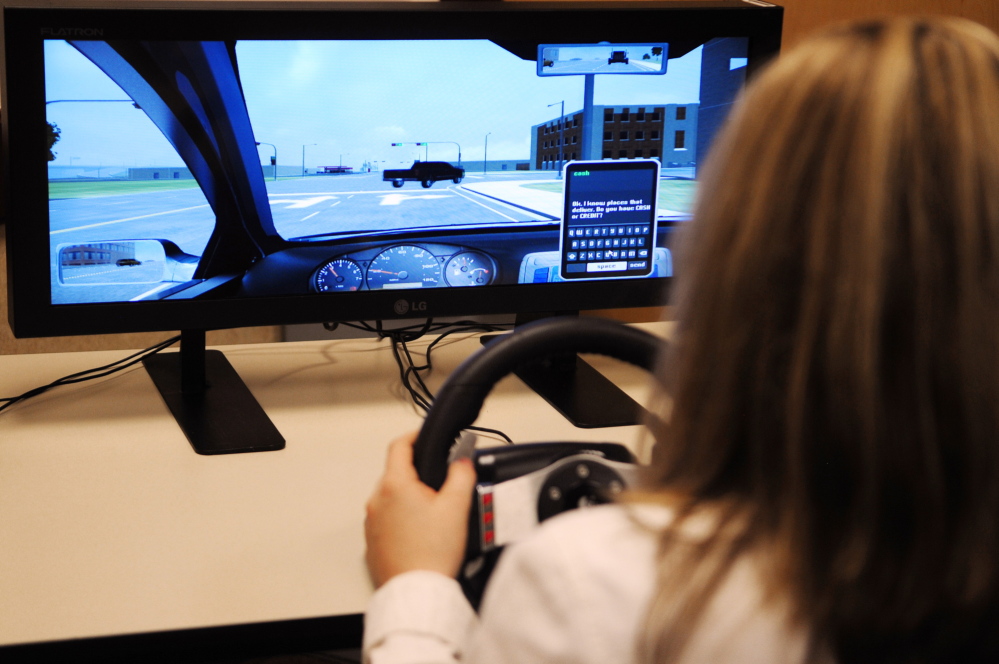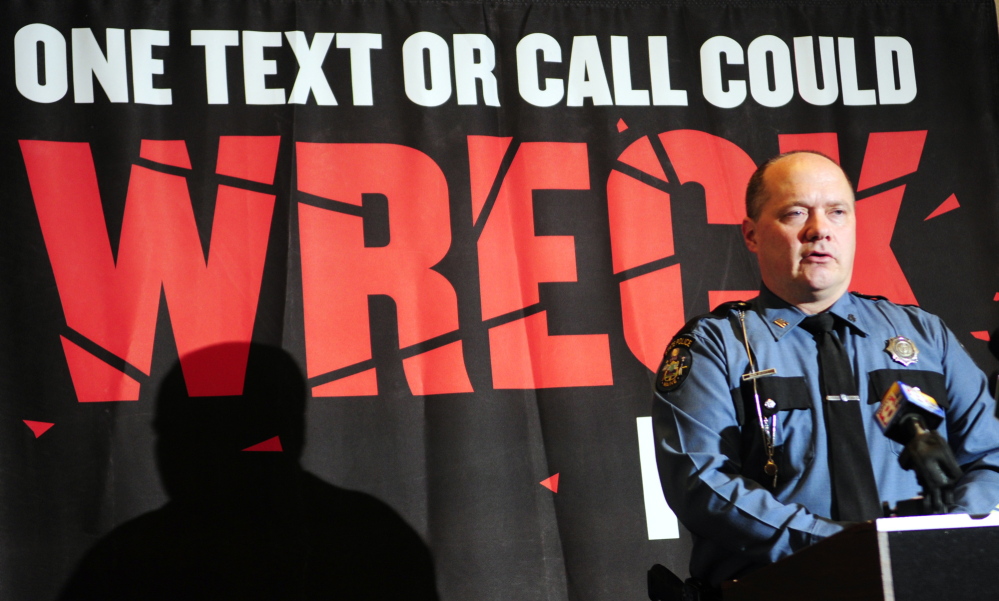There was the woman weaving over the highway while adjusting her radio. There was a driver reaching for the cigarette that had fallen on the floor whose car veered off the road and rolled over. There was even the University of Maine professor who corrected papers during her commute.
“She offered it to me as if it was a legitimate excuse,” said Trooper Duane Doughty, who patrols the interstate for the Maine State Police. “If you’re driving distracted you’re the same danger as a drunk driver.”
Police and highway officials on Thursday unveiled a new campaign, dubbed “One text or call could wreck it all,” to crack down on distracted driving.
Typically associated with texting or talking on a cellphone, distracted driving can include anything that takes a driver’s attention off the principal task of driving, said Col. Robert Williams, chief of the state police.
That includes the driver Williams stopped recently who was using one hand to hold her cellphone to her ear and the other to fumble with an item in the passenger’s seat.
“She had no hands on the wheel,” Williams said. “When I stopped to talk to her about it she was almost appalled I had the audacity to stop her.”
In 2012, more than 3,300 people killed in crashes involved distracted drivers nationwide and another 421,000 were injured, said Lauren Stewart, director of the State Bureau of Highway Safety. In Maine last year, there were 3,111 crashes involving distracted driving and 12 fatal crashes.
“Distraction occurs any time you take your eyes off the road, your hands off the wheel or your mind off your primary task, which is driving safely,” Stewart said. “Any non-driving activity increases your risk of crashing. Distracted driving kills.”
The four-year campaign against distracted driving will include public service announcements, signs with safety messages and in-school programs, Stewart said.
Williams said state police will step up its patrols, including the use of non-traditional methods, like using higher profile unmarked vehicles to allow a view of drivers inside their vehicles. Police are even partnering with companies to ride in commercial trucks. Troopers will also patrol near schools and sporting events.
Williams said police recently conducted a targeted patrol using troopers on an overpass on the interstate. Williams said the number of distracted drivers was chilling. Police simply could not keep up.
“For every one we stopped there were four or five we couldn’t stop,” Williams said.
Winthrop High School Principal Keith Morin said high schools across the state support programs to end distracted driving. The 13 schools in the Mountain Valley Conference, including Winthrop, have peer education programs and public service announcements. The campaign includes black rubber thumb rings that serve as visual reminder to students who are tempted to text while driving. Winthrop High School has set up mock accident scenes and student-produced videos.
“With banners hanging in most schools, literature placed in the hands of students along with thumb rings to prevent texting while driving, the messages are able to be revisited more than on an annual basis,” Morin said. “It takes a committed effort, not only on behalf of schools, but parents, community members and local and state public safety officials alike.”
Thursday’s press conference included a portable distracted driving simulator aimed at safely teaching the dangers of losing focus while driving. Kayleigh Oberg and Amber Raymond, both 14-year-old freshmen at Winthrop High School, each took a turn in the simulator. Both repeatedly hit something, or someone, and attracted the attention of digital police.
“It’s pretty scary,” Raymond said. “You can’t pay attention to the road.”
Raymond said she has ridden with someone who has texted while driving.
“It always gets me nervous,” she said. “You’re putting yourself in jeopardy and people around you. You could die.”
Oberg came into the day convinced of the perils of distracted driving, but driving while distracted was much more difficult than even she imagined.
“I’m not really familiar with all the street signs,” she said. “Adding a cellphone on the side is really hard.”
The fine for failure to control your vehicle is $119 and the fine for texting while driving $310 for the first offense. The fine for the second offense is $610 with a mandatory 30-day license suspension. Williams hopes those numbers, coupled with police enforcement, will be enough to convince drivers to remain focused on driving.
“We’re doing this to achieve voluntary compliance, to reduce crashes and, ultimately, to save lives,” Williams said.
Most drivers, when they see a police cruiser parked beside the road, instinctively slow down a bit, but Doughty said it is not uncommon for drivers talking on a cellphone to speed past his marked cruiser without even noticing he’s there. When stopped, the drivers typically are clueless that they had passed a trooper or how fast they were going when they did. When police get a report of a car swerving or changing speeds Doughty said it is assumed the driver is either drunk or distracted. He recently stopped a truck that was swerving so erratically that it nearly forced several cars off the road. Doughty thought perhaps the driver had fallen asleep.
“He was eating and trying to pick up a bottle off the floor,” Doughty said. “He was driving as bad as any drunk driver I’ve ever seen.”
Craig Crosby — 621-5642ccrosby@centralmaine.comTwitter: @CraigCrosby4
Send questions/comments to the editors.






Comments are no longer available on this story